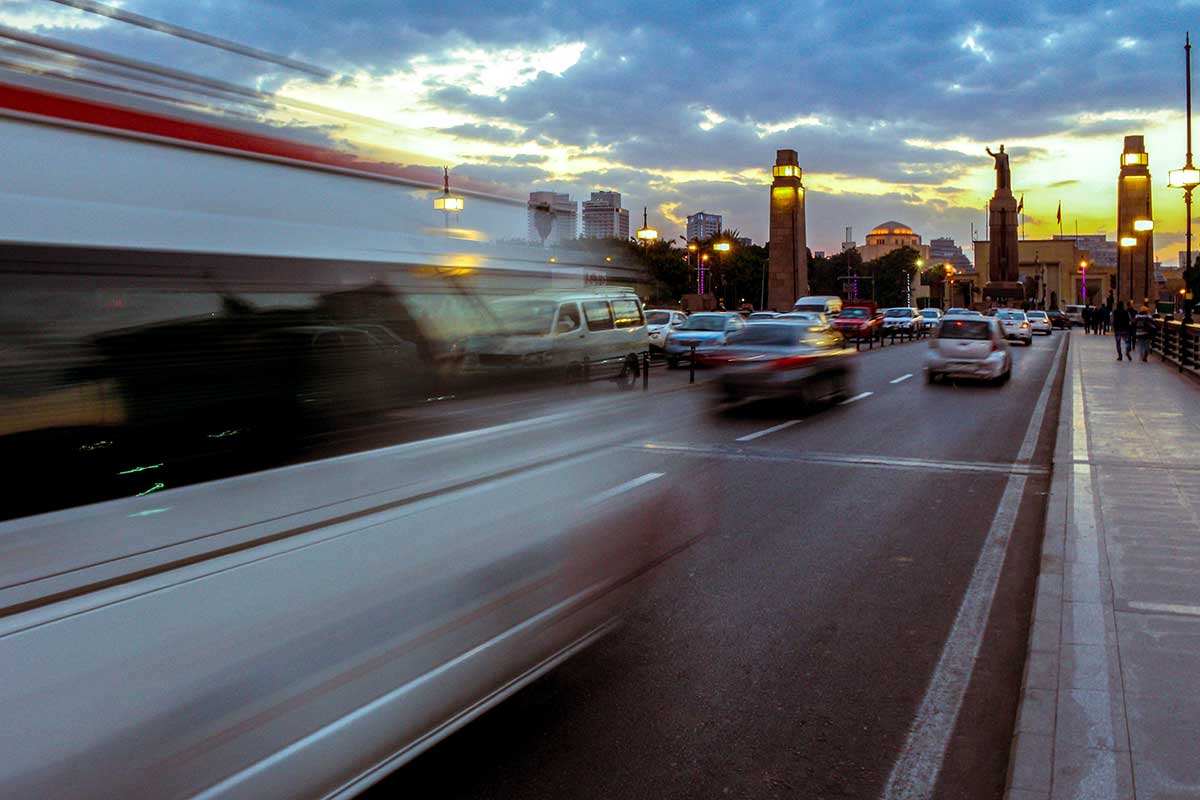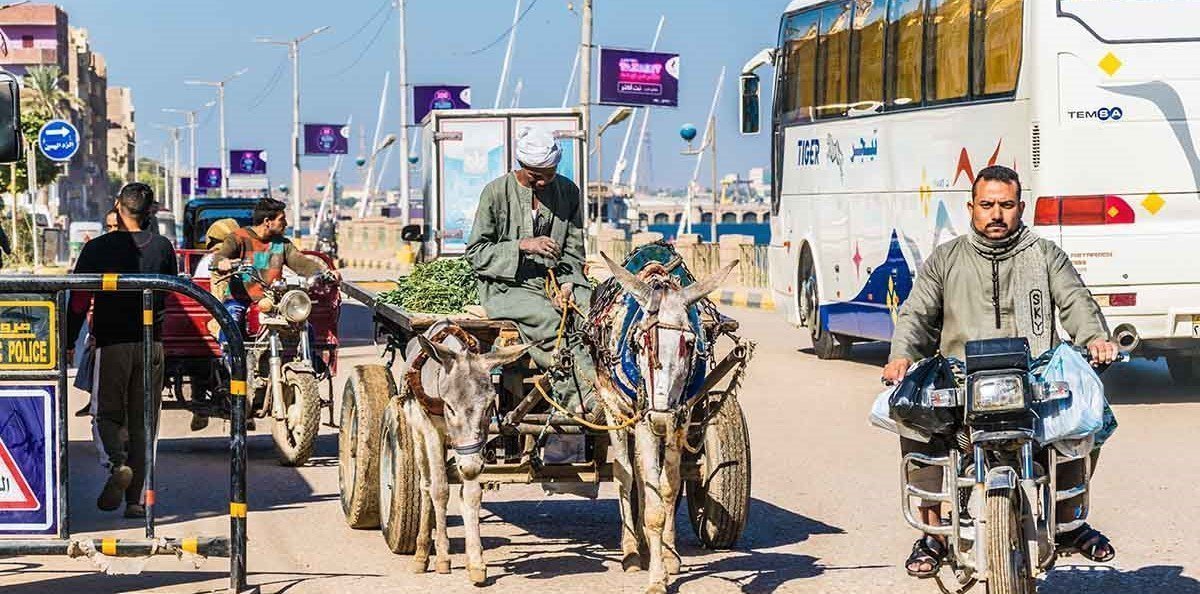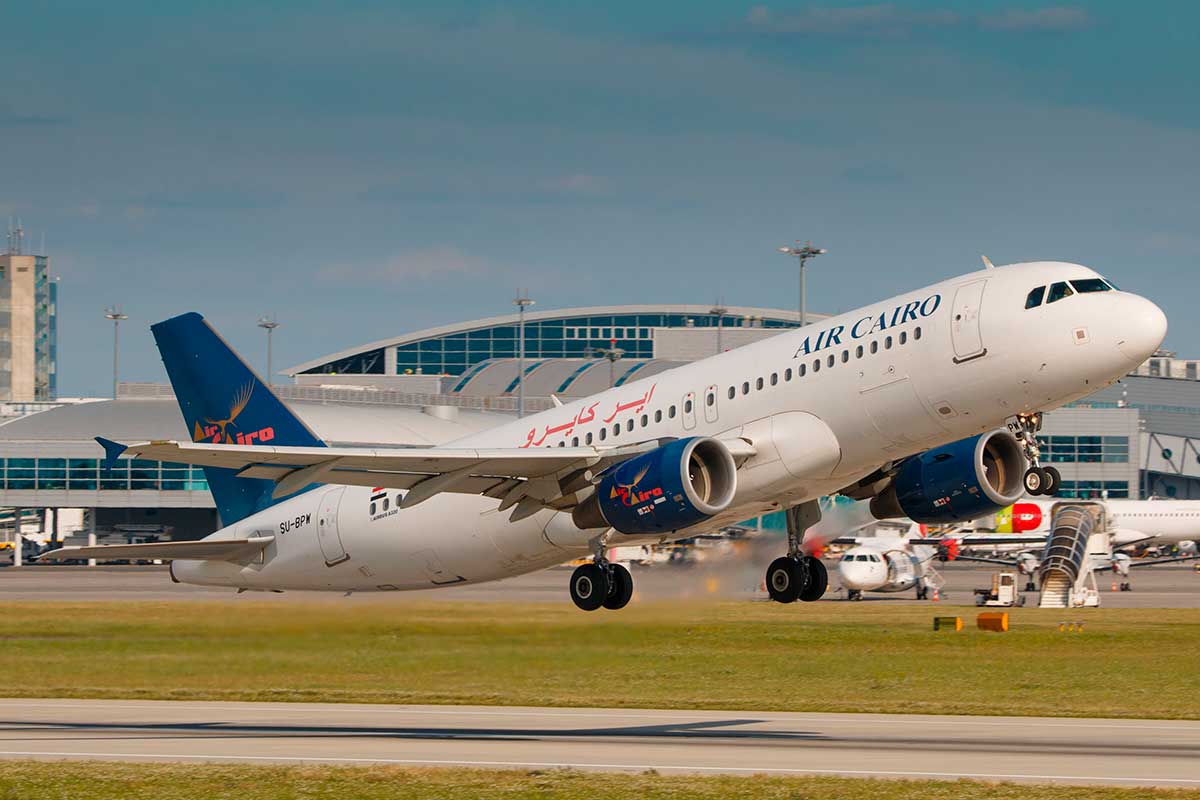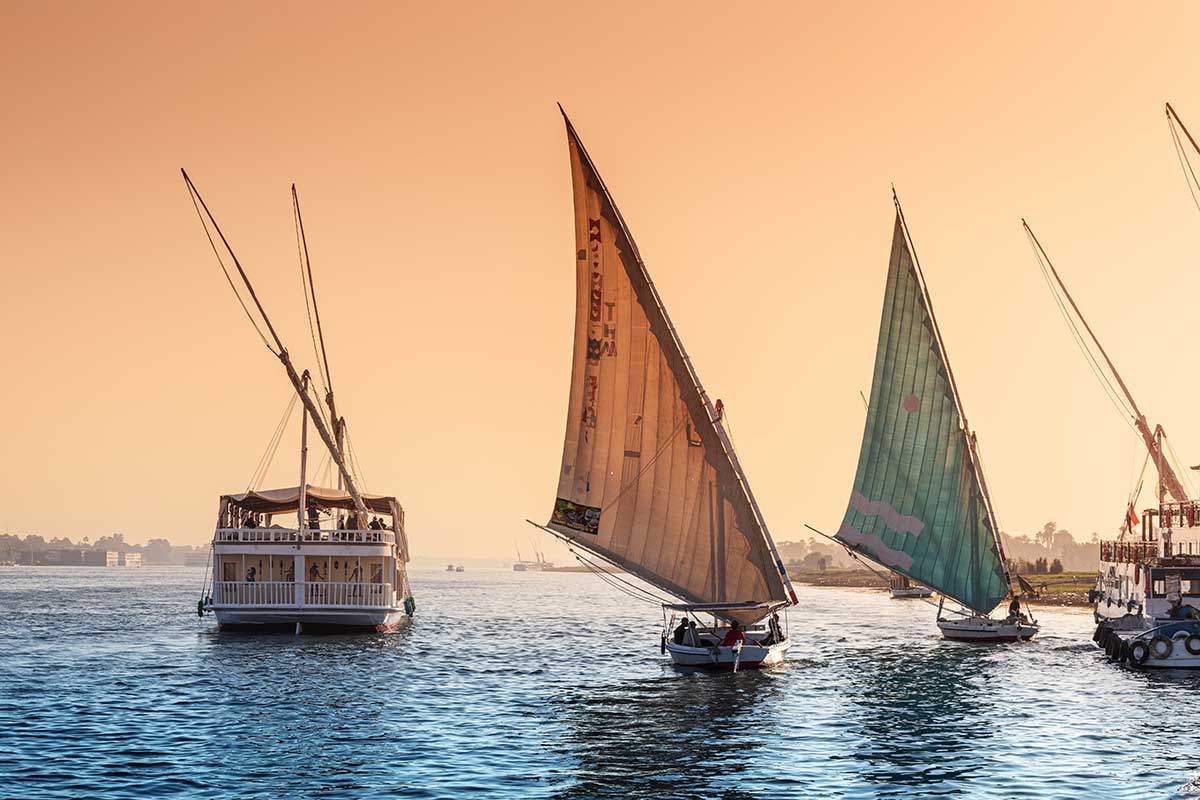Choosing the right transportation in Egypt can make or break your trip. The right mode of transportation will allow you to move comfortably and quickly between different cities and monuments within the country. On the other hand, the wrong one can cause delays and even fall below your quality standards. Egypt offers a wide variety of transportation options, but not all of them will be suitable for your type of trip. It’s crucial to take note of all the options available and carefully consider your decision. Additionally, if you need assistance with planning your trip, Egipto Exclusivo can manage even the smallest details of your travel arrangements.
When it comes to exploring Egypt, the first and foremost option on our list of transportation possibilities is the private vehicle with a driver, directly offered by Egipto Exclusivo. We believe it is the most recommended choice for several reasons, including its utility, safety, comfort, and time savings.
This transportation solution is a perfect blend of a rental car and a private taxi. You have the freedom of having a vehicle at your disposal for all necessary trips, even long-distance ones, without worrying about driving on the challenging roads of Egypt. Instead, a professional driver, who is an expert on the local roads, will take you wherever you need to go safely and efficiently.
Not only is this option popular among those looking for how to get around Egypt entirely, i.e., traveling between different tourist destinations, but it is also perfect for those who plan to make shorter urban trips or day trips. Additionally, it is an excellent choice for essential travel such as transfers to/from the airport.
One of the significant advantages of choosing a private vehicle with a driver from Egipto Exclusivo is the high-end vehicles they offer. These vehicles are meticulously clean and equipped with air conditioning that is always in perfect working order. Additionally, the experienced drivers have a keen sense of intuition, allowing them to navigate through traffic jams, which are common in large cities like Cairo.
Another advantage worth mentioning is the variety of vehicle models available. Egipto Exclusivo offers cars that can accommodate up to four passengers plus the driver, while 7 or 9-seater minivans are a popular option for country circuits, including the driver. These spacious and comfortable vehicles are perfect for covering long distances without any discomfort.
Regardless of whether you’re traveling alone, as a couple, or in a small or medium-sized group, Egipto Exclusivo has a range of vehicle models that can accommodate your needs. They are also flexible and can adapt to any requirement, offering total availability for schedules, with professionals who can speak your language.

If you want to have the freedom to move around Egypt without restrictions, renting a car is an excellent option. However, keep in mind that this freedom comes with certain limitations. These may include the location of the rental office, opening hours, the possibility of returning the car to a different branch, and other conditions outlined in the contract.
Major car rental companies like Sixt and Europcar operate in Egypt and have offices in key cities such as Alexandria, Aswan, Dahab, El Gouna, Hurghada, Luxor, Marsa Alam, Sharm el Sheikh, and Cairo. Their offices are strategically located near major transportation hubs, including airports, train stations, and popular vacation destinations.
Despite the convenience, renting a car in Egypt requires some considerations. The most significant issue to consider is the difference in driving culture compared to Western cities. Navigating the roads in big cities, particularly Cairo, can be challenging due to the different traffic rules when it comes to yielding, passing, parking, and maintaining a safe distance.
The traffic jams you will experience in these same cities and in the capital will test your patience, especially during peak hours. The state of the roads, especially the secondary network, is also something you should consider, as some insurance policies do not cover incidents that occur on poorly maintained roads. These factors greatly influence the decision on how to move around Egypt with a rental car.
While congestion is noticeable in large cities, outside of them, traffic is generally quite calm. The main highways are located in the vicinity of major cities and reach a width of four lanes in some cases. The toll road that connects Cairo with Alexandria, known as the “Desert Highway” (215 km), is the most important highway, as it enters its bordering the Delta to quickly connect these two major cities.
Other notable highways include the coastal road (280 km) that connects Alexandria with Port Said, the road connecting Port Said with Ismailia parallel to the Suez Canal, the road connecting Cairo with Suez, the ring roads of the capital, and the axis that connects Cairo with Asyut through the Eastern Desert parallel to the Nile River, maintaining several lanes per direction.
The speed limit is another important issue to consider while driving in Egypt. The speed limits are 50 km/h in the city, 90 km/h on secondary roads, and 100 km/h on highways. It is also important to note that gas stations are not abundant in areas far from urban areas, so if your journey is long, it is advisable to fill up the tank at every available service station.
For those who love the thrill of biking, an adventure through the desert and the land of the pharaohs is a dream come true. This section is dedicated to exploring how to get around Egypt on a motorcycle, as it’s a unique mode of transportation with several considerations to keep in mind.
While it may seem appealing to bring your motorcycle from home, it can be a daunting task due to the bureaucracy involved in entering the country with it. You will have to complete different permits and re-register your bike to ride on Egyptian soil. This process is not immediate and can take several days of waiting. However, if you choose to go this route, Egipto Exclusio can assist you in expediting the procedures and handling other details that may be useful for your motorcycle route.
But let’s be honest, it will be much easier for you to rent a motorcycle already in Egypt. Tourism and everything that this sector entails have renewed the catalog of experiences available to customers. And as more and more people wished to discover the country on two wheels, the possibilities of renting a motorcycle also increased significantly. In the main cities, you will find specialists in this service, and even in some vacation resorts. In this case, our agency can also arrange this service for you so that everything is ready when you arrive. And you will discover that if you have a biker’s soul and enjoy traveling through immense landscapes full of peace, there is nothing like getting around Egypt and its desert on a good motorcycle!
Taxi services are available in all cities and towns in Egypt, and it is deeply ingrained in Egyptian culture. However, not all cities have a metered taxi system, so you will have to negotiate the price before starting your journey. Additionally, before getting into a taxi in a large city, you must inform the driver of your destination, as they may refuse service due to traffic conditions.
While there are some common routes where the fare is more or less predetermined, there is room for negotiation when traveling between cities, as taxis are not only used within cities but also outside of them. Therefore, taxis can be a convenient solution to the question of how to get around Egypt.
On the other hand, sharing a taxi is a common practice, especially on urban routes. In these cases, the traveler pays for their seat and often has to wait until the vehicle is fully occupied before leaving. Additionally, it is possible to pay for two or more additional seats to leave them empty, with the intention of starting the journey as soon as possible or traveling with more comfort.
For those looking for a more modern option, Uber and its Arabic version, Careem, are available in Cairo, Alexandria, and some vacation spots with a high presence of foreign tourists, such as Sharm el-Sheikh. This can be a good solution for those who prefer to travel in comfort and have access to a reliable and recognizable transportation option. However, it is important to note that this option is not available in all cities in Egypt.
While taxis are a popular choice for travelers, there are other alternatives worth considering, although they are mainly reserved for local citizens. One option is minibuses and vans, which operate on regular routes similar to public transport but at a more affordable price. However, it may not be well-received for foreign tourists to take this mode of transport, so it may not be a viable solution for how to get around Egypt for tourism.
Another option that has become increasingly popular in crowded tourist destinations is the “tuk-tuk.” Although this mode of transportation originated in Southeast Asia, it has been introduced in Egypt, and is another option for getting around urban and tourist areas, especially for short trips. The drivers of tuk-tuks are usually hardworking individuals from humble backgrounds, so it can be an interesting way to connect with the local population.
Horse-drawn carriages, known as “calesas,” are another option to consider, but they are primarily used for tourist tours of places of interest. They are common at the Temple of Horus in Edfu or in the center of Luxor, but not typically used for normal urban or interurban travel.

If you’re considering public transport, traveling by bus is the way to go if you’re looking to explore different cities or regions in Egypt. It’s the most efficient mode of public transport that connects even the smaller cities, as the railway network doesn’t cover the entire country. One of the biggest advantages of traveling by bus is the affordability of the ticket, even for the high-end coaches.
Additionally, the bus fleet has been recently updated with coaches that meet all the required standards: air conditioning, television, toilets, comfortable seats with seat belts, and curtains to protect each seat from the sun. Since some of the journeys are quite long, overnight buses are a common option, allowing backpackers to get some rest during their travels.
Go Bus and Blue Bus are the two major bus companies that facilitate travel around Egypt. They connect nearly twenty cities and, in the case of the larger ones, stop at different stations. One of the most appealing aspects for foreign tourists is that they have an English website where it is possible to buy tickets in advance and without complications.
The main disadvantage of this option is the punctuality of the trips, which can sometimes suffer last-minute delays and are affected by traffic jams in large cities, especially for trips with departure or arrival points in Cairo.
And of course, all cities have a network of urban buses, more or less extensive depending on their size. Therefore, we recommend checking the page dedicated to each tourist destination to find out about this public service, as the price and number of lines varies in each case.
Train enthusiasts will find nothing quite like traveling around Egypt by train. The hustle and bustle of people at the stations or the integration of railways into the landscape are some of the reasons cited by advocates of this mode of transportation. However, comfort is not always a strong point in this country, as not all passenger trains offer high-quality standards.
As for conventional or daytime trains, it is very rare to see tourists on them. The two main lines are Cairo-Alexandria and Cairo-Aswan, which operate with slightly more modern trains. But on most lines, the age of the trains is coupled with poor services, excessively high occupancy, and standards that could be improved. Speed is also not their strong point, and since distances to be covered are often long, it is recommended to always use first class (darga ula).
In any case, it is always useful to know the network of railways in Egypt. It covers around 5,000 km of tracks and largely maintains the layout put into operation by the British in the 19th and early 20th centuries. This state railway map largely reproduces the natural design created by the Nile River in Egyptian geography.
The hub of Egypt’s railway system is located in the capital city, Cairo. Departing from Cairo, various lines head north, covering the entire Delta region and creating a spiderweb network that integrates the major cities in the area. Travelers interested in using trains to explore Egypt should also consider other railway lines located in the north of the country that do not run through the Delta. There are three, mainly:
Heading south, another railway line runs parallel to the Nile River and connects the main cities of Upper Egypt, with Aswan as the southernmost point of this axis. Along this central railway line, there are several secondary lines that branch off, such as the ones that reach the oases of Fayum, Bawiti, Kharga, and Baris in a westerly direction. To the east, the only existing line is the one connecting Qena and Safaga.
The Egyptian National Railways (ENR) is the state railway company, but its website is not user-friendly and mainly intended for consulting schedules and routes rather than purchasing tickets online. Therefore, many travelers opt for the bus as the primary means of public transportation when exploring Egypt.
While the daytime state rail network has significant gaps, night trains can be a great option for tourists looking to travel by rail in Egypt. They cover long distances, and since the journey is made at night, passengers can rest during the trip.
The main company that offers this service is Ernst, and their carriages have individual or double cabins. They operate daily routes between Cairo and Aswan, with stops in Giza and Luxor, making it a very interesting service for those interested in traveling this way through Upper Egypt. The complete route duration varies between 11 and 14 hours, depending on the number of stops made.
Finally, it is worth mentioning that an ambitious project to expand and improve this rail network is already underway, adding a high-speed line that will be of great use to tourists visiting the country and interested in traveling by train in Egypt. Some call it “the Nile’s AVE” as it runs parallel to the river. Aswan will be the southern end of the line, and starting from Cairo, it would run alongside the Rosetta branch, reaching Alexandria, which will be the northern end.
In addition to the state railway network, there are two other rail-based transport systems in Egypt that we will cover in this section on how to travel by train in the country. The first is the Metro, which currently exists only in Cairo, but there are plans to expand it to the city of Alexandria. The subway system in the capital consists of two lines, with a third line in the works. The network spans just over 60 km of track and 57 stations, and is a low-cost system widely used by Cairo residents.
The other urban rail transport system is the tram, which operates in Cairo and Alexandria. While the tram only has a few complementary lines to the urban bus and metro in the capital, it’s one of the best ways to navigate the city center in Alexandria, with 20 lines and 140 stations forming a dense network of 32 km.

For travelers embarking on a comprehensive tour of Egypt, flying is undoubtedly the best option for getting around. With around twenty airports scattered throughout the country, many of which offer domestic flights, tourists and business travelers can take advantage of the convenience of air travel, especially given the long distances between different destinations. For instance, Alexandria, located in the extreme north, is almost 1,100 km away from Aswan, one of the most important cities in the south.
Cairo International Airport serves as a major hub for transporting tourists to other destinations, with many international flights stopping over in the capital. But once inside the country, travelers can easily fly from one city to another without the need to transit through Cairo.
Below, we’ve listed all the airports in Egypt with passenger traffic, along with the cities or monuments they serve. This information is crucial in understanding how to get around Egypt by plane and can aid in planning your itinerary. However, we want to remind you that Egipto Exclusivo can also organize a fully customized tour for you.
In addition to airplanes, there is another way to soar over the country, although it does not solve the question of how to move around Egypt, as it is only a tourist experience and not intended as a means of transportation. We are talking about hot air balloons: our agency organizes tours of this type to get to know the desert or some of the most famous monuments of Ancient Egypt from a very special point of view, such as the Valley of the Kings in Luxor.

A visit to Egypt would not be complete without a boat ride on the Nile, whether it’s a small traditional sailboat or a larger motor vessel for a multi-day cruise or a few hours of excursion in a single day.
However, using a boat as a means of transportation like buses, trains, planes, or cars is more complicated in Egypt. Although the Nile could be considered a “river highway” without traffic jams, there are only ferries with regular and public lines available. Hence, if you want to use a boat to travel between two cities or two areas of the same large city, like Cairo, you will need to hire a private service.
While Lake Nasser has ferries with scheduled departures and arrivals, they only travel to Sudan, making them unsuitable for transportation within southern Egypt.
In any case, our agency can create a personalized itinerary that includes boat trips to transport you from one place to another. We also offer cruises with set routes where the boat becomes your accommodation. Here are the available options:
No matter what type of boat you choose, Egipto Exclusivo offers a range of options to suit different preferences and budgets. From standard to true luxury, we have it all. For those seeking the ultimate in quality and attention to detail, we offer falucas and dahabiyas with a special history, built by the founders of our agency.
Outside the Nile area, private and personalized boat services are also available. Catamaran routes between several ports on the Red Sea coast, such as Sharm el Sheikh and Hurghada, are particularly popular and offer access to first-class marinas. Whether you choose to explore the Nile or the Red Sea, our agency can create a customized route to suit your needs and preferences.
Other alternative transportation options are also mentioned before concluding this guide on how to travel around Egypt during your trip:
Fill out the form below to receive a free, no-obligation, tailor-made quote from an agency specialized in Egypt.
Travel agency and DMC specializing in private and tailor-made trips to Egypt.
Mandala Tours, S.L, NIF: B51037471
License: C.I.AN-187782-3